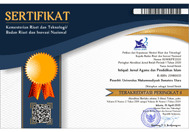Pengaruh Strategi Pembelajaran Think Talk Write dalam Kelompok Kecil Terhadap Kemampuan Berpikir Kreatif dan Pemahaman Pada Siswa MTs Negeri 2 Medan
Abstract
This study uses a combined technique between quantitative and qualitative research to see a variable that is the Think Talk Write learning strategy on students' creative understanding and thinking as a variable that accompanies the learning strategy variable Think Talk Write. The sample in this study were students of class VII1 and VII2 at MTsN 2 Medan in Langkat District with 40 students in the experimental class and 40 students in the control class. The conclusions of this study are as follows; 1) Class VII students of MTsN 2 Medan who obtained the Think Talk Write learning strategy approach showed that the understanding of the History of Islamic Culture was significantly better compared to students who had regular learning; 2) Creative thinking of class VII students of MTsN 2 Medan who obtained learning with the learning strategy approach of Think Talk Write showed that it was significantly better compared to students who learned normally; 3) There is a positive correlation between understanding the history of Islamic culture and the ability of students to think creatively. In the experimental group class the results showed that the correlation of understanding of Islamic Culture History to students' creative thinking skills was greater compared to the control group class; 4) The attitude of students to Islamic Culture History lessons, through the learning strategy approach Think Talk Write and on the matter of understanding History Islamic culture and the ability to think creatively are positive; 5) The activities of students who get the Think Talk Write learning strategy approach are more active in learning, especially discussing with friends, and also students are more daring to express or ask questions to the teacher, and be more creative in solving the problems given.
Keywords
Full Text:
PDF (Bahasa Indonesia)References
Al Mahalli, Imam Jalaluddin dan As Suyuti, Imam Jalaluddin. (2011). Terjemahan Tafsir Jalalain Berikut Asbabun Nuzul; Jilid 1, Bandung: Sinar Baru Algesindo.
Ansari, B.I. (2003). Menumbuhkembangkan Kemampuan Pemahaman dan Komunikasi Melalui Strategi Think Talk Write (Eksperimen di SMUN Kelas I Jakarta), Jakarta: Disertasi Doktor pada Universitas Islam Negeri Syarif Hidayatullah: Tidak diterbitkan.
Arikunto, S. (2002). Prosedur Penelitian Suatu Pendekatan Praktek. Edisi Revisi V, Jakarta: Rineka Cipta.
Artzt, A.F. (1996). Developing Problem-Solving Behaviors by Assessing Communiction in Cooperative Learning Groups. Dalam P.C Elliot dan M.J Kenney (Eds). Yearbook Communication in Learning K-12 and Beyond. Reston, VA: The National Council of Teachers of Education.
Baroody, A.J. (1993). Problem Solving, Reasoning, and Communicating. K-8: Helping Children Think Learning, New York: Mac Millan Publishing Company.
Blakey, E., Spence, dan Sheila. (1990). Developing Metacognition. ERIC Digest, ERIC Clearing House on Information Resources, 030 Huntington Hall, Syracuse, NY 13244-2340.
Budi, A. (2016). al Quran dalam Persepektif Sains dan Teknologi, Jakarta: Berlian Press.
Carin, A.A. & Sund, R.B. (1975). Teaching Science through Discovery, Ohio: Charles E. Merril Publishing Company.
Corwin, R.B. (2002). Supporting Talk in Classroom. [Online].
Cropley, A.J (1992). More Ways than One: Fostering Creativity, Norwood, New Jersey: Ablex Publishing Co.
Departemen Pendidikan Nasional. (2002a). Pembelajaran Berdasarkan Pendekatan Konstruktivisme dan Kontekstual, Jakarta: Direktorat Pendidikan Lanjutan Pertama.
Departemen Pendidikan Nasional. (2002b). Pendekatan Kontekstual. Jakarta: Direktorat Pendidikan Lanjutan Pertama.
Departemen Pendidikan Nasional. (2003). Materi Pelatihan Peningkatan Kemampuan Guru dalam Penyusunan dan Penggunaan Alat Evaluasi, Jakarta: Direktorat Pendidikan Lanjutan Pertama.
Diniyati, P. (2015). Peningkatan Kemampuan Komunikasi dan Kemampuan Pemecahan Masalah Melalui Strategi Pembelajaran Think Talk Write Pada Siswa Kelas VII MTs Jawa Barat. Bandung: Universitas Islam Negeri Sunan Gunung Djati, Tesis tidak diterbitkan.
Downs, J.M. dan Downs, M. (2002). Advanced Thinking with a Special Reference to Reflection on Learning Structure. Dalam L.D English (Ed). Handbook International Research in Education, New Jersey: Lawrence Erlbaum Associates.
Even, R. dan Tirosh, D. (2002). Teacher Knowledge and Understanding of Students Learning. Dalam L.D English (Ed). Handbook of International Research in Education, New Jersey: Lawrence Erlbaum Associates.
Feldmann, M.B. (2002). Creatif Thinking Project. EDU658. [Online].
Fogarty, R. (1997). Problem-Based Learning and Other Curriculum Models for the Multiple Intellegences Classroom. Australia: Hawker Brownlow Education.
Fraenkel, J.R. dan Wallen, N.E. (1990). How to Design and Evaluate Research in Education, USA: Mc Graw-Hill Publishing Company.
Goldin, G.A. (2002). Creatif Thinking in Learning and Problem Solving. Dalam L.D English (Ed). Handbook of International Research in Education, New Jersey: Lawrence Erlbaum Associates.
Hapsari, P.A. (2015). Metodologi Penelitian Kualitatif: Teori dan Praktik, Semarang: Insan Cita Persada.
Harris, R. (1998). Introduction to Creative Thinking(Online), (20 Desember 2004).
Qorib, M. (2018). Pluralisme Buya Syafii Marif. Kumpulan Buku Dosen, 1(1).
Nurzannah, A., & Daulay, M. Y. (2017). Akidah dan Akhlak.
AKRIM, M., & HARFIANI, R. Daily learning flow of inclusive education for Early Childhood.
Harvey, R. (2000). Does Language Interfere with Learning? Dalam Yearbook Learning for a New Century. Reston, VA: The National Council of Teachers of Education.
Hasanah, A. (2004). Mengembangkan Kemampuan Pemahaman dan Penalaran Siswa Sekolah Menengah Pertama melalui Pembelajaran Berbasis Masalah yang Menekankan pada Kemampuan Berpikir Kreatif. Tesis pada Universitas Islam Negeri Syarif Hidayatullah, Jakarta: Tidak diterbitkan.
Haylock, D.W. (1997). Recognising Learning Creativity in Schoolchildren, ZDM: International Reviews on Learning Education. 29 (3).
Hikmawan. (2016). Pengaruh Strategi Pembelajaran Think Talk Write Terhadap Kemampuan Komunikasi dan Kemampuan Pemahaman Siswa Kelas VII MTs Negeri 1 Jakarta, Jakarta: Universitas Islam Negeri Syarif Hidayatullah, Tesis tidak diterbitkan.
Hudojo, H. (2002). Berpikir Kreatif Dalam Belajar Berbasis Masalah. Prosiding Konferensi Nasional Pendidikan XI, Edisi Khusus.
Huinker, D.A. dan Laughlin, C. (1996). Talk Your Way Into Writing. Dalam P.C Elliot dan M.J Kenney (Eds). Yearbook Communication in Education K-12 and Beyond, Reston, VA: The National Council of Teachers of Education.
Huinker, D.A. dan Laughlin, C. (1996). Talk Your Way into Writing. Dalam P.C Elliot dan M.J Kenney (Eds). Yearbook Communication in Education K-12 and Beyond. Reston, VA: The National Council of Teachers of Education.
Jacob, C. (2002). Berpikir Kreatif Sebagai Komunikasi. Prosiding Konferensi Nasional Pendidikan XI, Edisi Khusus.
Johnson, D.W., Johnson, R.T., dan Holubec, E.J. (1994). Cooperative Learning in the Classroom, Virginia: Association for Supervision and Curriculum Development.
Kementrian Agama Republik Indonesia. (2016a). al Quran dan Terjemahan, Edisi IX, Jakarta: Kementrian Agama.
Kementrian Agama RI. (2016b). al Quran dan Terjemahannya, Jakarta: Kementrian Agama Republik Indonesia.
Khairi, A. (2015). Evaluasi Proses Pembelajaran MI, MTs, dan MA, Jakarta: Universitas Islam Negeri Syarif Hidayatullah.
Krutetskii, V.A. (1976). The Psychology of Learning Abilities in Schoolchildren, Chicago: University of Chicago Press.
Lie, A. (2002). Cooperative Learning: Mempraktekkan Cooperative Learning di Ruang-Ruang Kelas, Jakarta: Grasindo.
Malone, J.A. dan Krismanto, A. (1997). Indonesian Students Attitudes and Perceptions Towards Small-Group Work in Learning. Dalam Journal of Science and Educations in Southeast Asia. XVI (2).
Masingila, J.O. dan Wisniowska, E.P. (1996). Developing and Assessing Understanding in Through Writing. Dalam P.C Elliot dan M.J Kenney (Eds). Yearbook Communication in K-12 and Beyond. Reston, VA: The National Council of Teachers of Education.
Meltzer, D.E. (2002). The Relationship Between Preparation and Conceptual Learning Gain in Learning: A Possible Hidden Variable in Diagnostics Pretest Scores. Dalam American Journal of Learning. [Online].
Munandar, S.C.U. (1977). Creativity and Education. Disertasi Doktor, Universitas Indonesia, Jakarta: Departemen Pendidikan dan Kebudayaan.
Munandar, S.C.U. (1999) Kreativitas dan Keberbakatan, Strategi Mewujudkan Potensi Kreatif dan Bakat, Jakarta. PT. Gramedia.
Munandar, S.C.U. (2005). Pendidikan Kita Belum Dukung Kreativitas Anak. Republika [Online], satu halaman. Tersedia: [11 Maret 2005].
Munandar, S.C.U., Munandar A.S. dan Semiawan, C. (1990). Memupuk Bakat dan Kreativitas Siswa Sekolah Menengah, Jakarta: PT. Gramedia.
Nofisaky. (2016a). Evaluasi Pembelajaran: Teori dan Praktik, Bandung: Azalea.
Nofisaky. (2016b). Metodologi Penelitian: Kuantitatif, Kualitatif, Tindakan Kelas, Pengembangan, dan Gabungan, Jakarta: Angkasa Raya Press.
Nofisaky. (2016c). Pembelajaran Pendidikan Agama Islam: Konsep dan Praktik, Bandung: Azalea.
Nofisaky. (2016d). Pendidikan Agama Islam: Konsep dan Praktis, Jakarta: UIN Syarif Hidayatullah Press.
Nofisaky. (2016e). Strategi Pembelajaran: Teori dan Praktik, Bandung: Azalea.
Pehkonen, E (1997). Fostering Learning Creativity. International Review on Learning Education. 29 (3) [Online].
Perkins, D.N. (1986). Thinking Frames. Educational Leadership. 43 (8).
Perry, B. dan Dockett, S. (2002). Young Childrens Access to Powerfull Ideas. Dalam L.D English (Ed). Handbook of International Research in Education, New Jersey: Lawrence Erlbaum Associates.
Ratnaningsih, N. (2003). Mengembangkan Kemampuan Berpikir Siswa Sekolah Menengah Umum Melalui Pembelajaran Berbasis Masalah (Studi Eksperimen pada Siswa SMUN 1 Tasikmalaya), Tesis pada Universitas Islam Negeri Sunan Gunung Djati: Tidak diterbitkan.
Renata. (2016). Evaluasi Pembelajaran PAI, Jakarta: Mutiara Press.
Rubenstein, R.N. dan Thompson, D.R. (2001). Learning Symbolism: Challenge and Instructional Strategies, New York: New York Press.
Ruseffendi, E.T. (1991a). Pengajaran Modern Untuk Orang Tua, Murid, Guru, dan SPG Seri Kelima, Bandung: Tarsito.
Ruseffendi, E.T. (1991b). Pengantar Kepada Membantu Guru Mengembangkan Kompetensinya dalam Pengajaran untuk Meningkatkan CBSA, Bandung: Tarsito.
Ruseffendi, E.T. (1998a). Dasar-Dasar Penelitian Pendidikan dan Bidang Non Eksakta Lainnya, Semarang: IKIP Semarang Press.
Ruseffendi, E.T. (1998b). Statistika Dasar Untuk Penelitian Pendidikan. Bandung: IKIP Bandung Press.
Sani, A. (2016). Pembelajaran Sejarah Kebudayaan Islam Tingkat MI, MTs dan MA, Bandung: Pena Press.
Schoenfeld, A.H. (1992). Learning to Think: Problem Solving, Metacognition, and Sense Making in Learning. Handbook of Research on Teaching and Learning, New York: McMilan Publishing Co.
Sejati, U. (2014). Hubungan Strategi Pembelajaran Think Talk Write Terhadap Kemampuan Berpikir Kreatif dan Kemampuan Komunikasi Siswa Kelas VIII MTs Negeri 5 Semarang, Jawa Tengah: Universitas Islam Negeri Sunan Kalijaga, Tesis tidak diterbitkan.
Setiono, K. (1993). Teori Perkembangan Kognitif, Bandung: Universitas Padjadjaran.
Shihab, M. Q. (2010). al Quran dan Maknanya, Jakarta: Lentera Hati.
Silver, E.A. (1997). Fostering Creativity Through Instruction Rich in Problem Solving and Problem Posing. ZDM: International Reviews on Education (1997). 29 (3).
Silver, E.A. dan Smith, M.S. (1996). Building Discourse Communities in Classrooms: A Worthwhile but Challenging Journey. Dalam P.C Elliot dan M.J Kenney (Eds). Yearbook Communication in K-12 and Beyond. Reston, VA: The National Council of Teachers of Education.
Sudjana. (1992). Metoda Statistika, Bandung: Tarsito.
Sudjana. (2011). Metoda Statistika, Edisi Revisi Ke VI, Bandung: Tarsito.
Suherman, E. dan Kusumah, Y.S. (1990). Petunjuk Praktis Untuk Melaksanakan Evaluasi Pendidikan, Bandung: Wijayakusumah.
Sumarmo, U. (2003). Pembelajaran Ketrampilan Membaca Pada Siswa Sekolah Menengah dan Mahasiswa Calon Guru, Makalah pada Seminar Nasional Pendidikan Universitas Islam Negeri Syarif Hidayatullah.
Sumarmo, U. (2004). Pembelajaran Untuk Mendukung Pelaksanaan Kurikulum Berbasis Kompetensi, Makalah pada Pertemuan SMPN 1 Tasikmalaya.
Supriadi, D. (1994). Kreativitas, Kebudayaan dan Perkembangan IPTEK, Bandung: Alfabeta.
Szetela. (1993). Facilitating Communication for Assessing Critical Thinking in Problem Solving. Dalam Webb, N.L dan Coxford, A.F (Eds). Yearbook Assessment in Learning Classroom. Reston, VA: The National Council of Teachers of Education.
Tim Kementrian Agama. (2016). Pendidikan Agama Islam Tingkat MI, MTs dan MA : Teori dan Praktik, Jakarta: Dirjen Pendidikan Dasar dan Menengah Kementrian Agama Republik Indonesia.
Torrance, E.P. (1969). Creativity What Research Says to the Teacher, Washington DC: National Education Association.
Wahyudin. (2000). Kemampuan Guru, Calon Guru dan Siswa dalam Pembelajaran, Jakarta: Disertasi PPS UIN Syarif Hidayatullah: Tidak diterbitkan.
AKRIM, Akrim; PARIDAH, Paridah. Upaya Meningkatkan Motivasi Keberanian ANak Untuk Perfomence Melalui Strategi Permain Peran di RA Al-Muslihin Binjai. JEMS: Journal of Education and Mathematical Science, 2019, 1.1.
DOI: https://doi.org/10.30596/intiqad.v11i1.3137
Refbacks
- There are currently no refbacks.
Intiqad Jurnal Agama dan Pendidikan Islam is abstracting & indexing in the following databases:
View My StatsEditorial Address:
Faculty of Islamic Religion, Universitas Muhammadiyah Sumatera Utara. Jl. Mukhtar Basri No. 3 Medan 20238 Telp. (061) 6622400 ext. 27 dan 28 Fax. (061) 6625474. e-mail: intiqad@umsu.ac.id

























